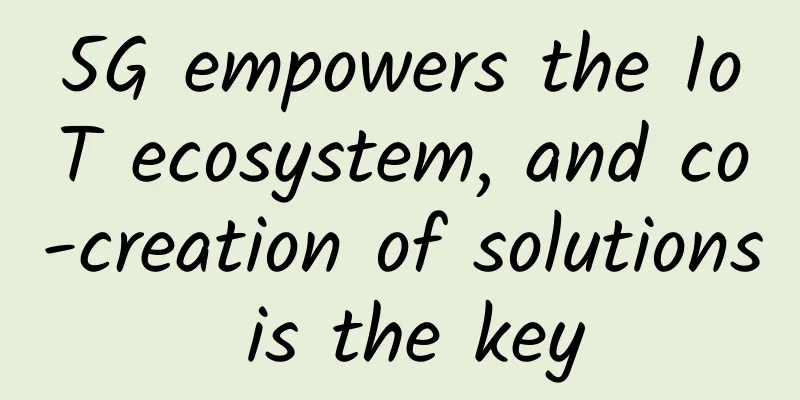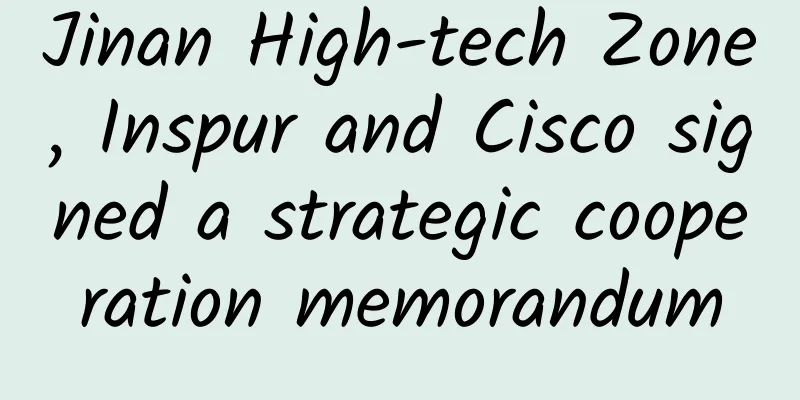These 22 IoT terms will make others worship you just by saying any one of them

|
Improve your chat style and enter the IoT circle with these 22 terms! 1. 6LoWPAN 6LoWPAN is the abbreviation of "IPv6 over low-power personal area networks". It is a low-speed wireless personal area network standard that implements IPv6 communication based on IEEE 802.15.4. The biggest advantage of 6LoWPAN is its low-power support, which can be applied to almost all devices, including handheld devices and high-end communication equipment; it has built-in AES-128 encryption standard and supports enhanced authentication and security mechanisms.
2. AMQP (Advanced Message Queuing Protocol) AMQP is an application layer standard advanced message queuing protocol that provides unified messaging services. It is an open standard for application layer protocols and is designed for message-oriented middleware. Clients and message middleware based on this protocol can pass messages without being restricted by different client/middleware products, different development languages, etc. Implementations in Erlang include RabbitMQ, etc. AMQP is part of many commercial middleware integration products, including Microsoft's Windows Azure Service Bus, VMware's RabbitMQ, and IBM's MQlight. It was originally developed by the financial sector for fast M2M communications, but has begun to be used in IoT projects. 3. Multiple low-power Bluetooth There are two main forms of the Bluetooth wireless communication protocol commonly used in the Internet of Things. The standard variety is used for small smart home accessories, connected refrigerators, showers, speakers, door locks and other devices; Bluetooth Low Energy, often referred to as BLE, is more attractive for large networks of limited connected devices because it solves the problem of short battery life. Both Bluetooth protocols were updated in December 2016, extending the effective range of Bluetooth devices and increasing the transmission volume. 4. Cellular Data Needless to say, although cellular data is not the most efficient wireless connection method, most IoT deployments currently use wireless data from telecommunications operators as a means of transmission. 5. CoAP (Constrained Application Protocol) CoAP is an Internet protocol. Since many devices in the Internet of Things are resource-constrained, that is, they have only a small amount of memory space and limited computing power, the traditional HTTP protocol is too large to be applied to the Internet of Things, resulting in a small horse pulling a big cart. The CoRE working group of IETF proposed a CoAP protocol based on the REST architecture. CoAP is an application layer protocol in the 6LowPAN protocol stack. After introducing the content, characteristics and interaction model of the CoAP protocol in detail, this article uses the Contiki embedded operating system on the uIPv6 START KIT wireless network development kit to implement the CoAP protocol not only on the browser side but also with the client program written by itself, and adds the interaction function between the database, so that the function of viewing not only real-time data but also historical data on the Web interface can be realized. 6. DDS (Data Distribution Service) DDS is a new generation of distributed real-time communication middleware technical specifications developed by the Object Management Group (OMG) based on standards such as HLA and CORBA. DDS adopts a publish/subscribe architecture, emphasizes data-centricity, provides rich QoS service quality strategies, and can ensure real-time, efficient and flexible data distribution to meet the needs of various distributed real-time communication applications. 7. HomeKit HomeKit is Apple's own-brand smart home device front end and control device. With HomeKit, users can use iOS devices to control all accessories in their home that are marked "Works with Apple HomeKit". These accessories include lights, locks, thermostats, smart plugs and other accessories. The "HomeKit" software project itself does not produce new products equipped with the HomeKit system, but authorizes third-party manufacturers to produce equipment that meets Apple's compatibility and security standards. Products using HomeKit software must meet a series of compatibility and encryption standards. The former allows it to support HomeKit products produced by other manufacturers, while the latter prevents hackers from taking over computer systems or stealing user information. 8. IoTivity IoTivity is an open source project led by Intel and Samsung, with the goal of establishing a unified IoT device connection standard. It is developed by a number of technology giants, including Microsoft, Intel, Qualcomm, LG and Samsung. It is used to seamlessly support device-to-device connectivity, mainly to meet the needs of IoT development, build an IoT ecosystem, and enable secure and reliable connections between devices. 9. JSON-LD JSON-LD is the abbreviation of JavaScript Object Notation for Linked Data. It is a method of representing and transmitting linked data based on JSON. JSON-LD describes how to represent directed graphs through JSON and how to mix linked data and non-linked data in one document. The syntax of JSON-LD is compatible with JSON. Based on JSON-LD, linked data can be used in a web-based programming environment, interoperable linked data web services can be constructed, and linked data can be saved in a JSON-based storage engine. 10. LoRaWAN LoRaWAN is a low-power wide area network specification launched by the LoRa Alliance. This technology can provide regional, national or global networks for battery-powered wireless devices. LoRaWAN targets some core requirements in the Internet of Things, such as secure two-way communication, mobility and local services. This technology does not require complex local configuration, which allows smart devices to achieve seamless interoperability and gives users, developers and enterprises in the field of the Internet of Things free operation rights. 11. MQTT (Message Queuing Telemetry Transport) MQTT is an instant messaging protocol developed by IBM that is likely to become an important part of the Internet of Things. The protocol supports all platforms and can connect almost all networked objects to the outside world. It is used as a communication protocol for sensors and actuators (such as connecting a house to the Internet via Twitter). 12. NFC (Near Field Communication) This technology is already very familiar to everyone. It evolved from contactless radio frequency identification (RFID) and was jointly developed by Philips, Nokia and Sony. It is based on RFID and interconnection technology. NFC is a short-range high-frequency radio technology that operates at a frequency of 13.56MHz within a distance of 10cm. Its transmission speed is 106 Kbit/s, 212 Kbit/s or 424 Kbit/s. At present, near-field communication has become the ISO/IEC IS 18092 international standard, ECMA-340 standard and ETSI TS 102 190 standard. 13. Physical Web The Physical Web is a project developed by Google that aims to extend the virtual web to the physical world around us. Its goal is to develop a set of common web standards that any device (not just Google's devices) can use to provide interactions and a set of services. Using this set of standards, smart devices can broadcast their URL addresses to the surroundings, and any device around them (such as smartphones and tablets) should be able to receive these URLs and present them to users. Users can then interact directly with these devices as needed without having to download apps. 14. SCADA (Supervisory Control And Data Acquisition) SCADA system is a computer-based DCS and power automation monitoring system; it has a wide range of applications, and can be used in data acquisition and monitoring control and process control in the fields of power, metallurgy, petroleum, chemical industry, gas, railways, etc. In the power system, SCADA system is the most widely used and the technology is the most mature. It occupies an important position in the telecontrol system, and can monitor and control the operating equipment on site to realize various functions such as data acquisition, equipment control, measurement, parameter adjustment and various signal alarms, which are the "four remote" functions we know. RTU (remote terminal unit) and FTU (feeder terminal unit) are its important components. It plays a very important role in the construction of comprehensive automation of substations today. 15. Sigfox The Sigfox protocol is owned by a French company and is mainly used to build wireless networks between low-power devices such as electricity meters, smart watches, washing machines, etc. that need to continuously transmit small amounts of data. Its infrastructure determines that it can make its own space in the field of the Internet of Things. Sigfox claims to be "the first and only company to provide global cellular connectivity for the Internet of Things." Its infrastructure is completely independent of existing networks such as telecommunications networks. Sigfox is currently seeking solutions to "deploy billions of objects and thousands of new uses" in order to achieve the long-term goal of processing PB-level data generated by everyday items. 16. SMS SMS, a seemingly ancient communication medium, can be used for communication for certain types of IoT devices. For example, Mobike’s smart lock initially used SMS communication. SMS is indeed a good choice for devices that are distributed over a large geographical area and have a certain amount of delay tolerance. 17. Thread Thread is a new network protocol launched by Google's Nest in July 2014 in collaboration with Samsung, ARM, Silicon Labs, etc. Thread is a mesh network protocol based on a simplified version of IPv6, designed to connect various products in the home, as well as the Internet and the cloud. Thread is developed based on the low-cost, low-power 802.15.4 chipset and covers the 6LoWPAN protocol. 18. TR-069 TR-069 is one of the technical specifications developed by the DSL Forum (www.dslforum.org), and its full name is "CPE Wide Area Network Management Protocol". It provides a general framework and protocol for managing and configuring home network devices in the next-generation network, and is used to remotely and centrally manage gateways, routers, set-top boxes and other devices in the home network from the network side. In the framework defined by TR-069, there are mainly two types of logical devices: managed user equipment and management server (ACS). In a home network environment, the devices that need to be configured and managed from the network side are generally devices directly related to the operator's business, such as home gateways, set-top boxes, IP phone terminals, etc. All configuration, diagnosis, upgrade and other tasks related to user equipment are completed by a unified management server ACS. 19. Weave Weave is a low-power, low-bandwidth, low-latency, secure device-to-device communication protocol originally developed by Nest and used in their own devices. Weave runs on Thread or Wifi, using 802.15.4 or 802.11 wireless signals. Any IoT device that runs on these two frequency bands and supports software upgrades can use Weave and benefit from its powerful features. In terms of hardware, the minimum configuration requirement is an ARM M-class SoC chip with 64KB RAM. According to Nest, Weave has been working well on devices with their own batteries for many years. In addition, it can also run on smart homes using ARM R and A-Class controllers, which generally have a long-lasting power supply. The improved Weave protocol can also run on Bluetooth, LTE or Ethernet. 20. XMPP (eXtensible Messaging and Presence Protocol) XMPP is a protocol based on XML, a subset of the standard universal markup language, which inherits the flexible development in the XML environment. Therefore, applications based on XMPP have super scalability. After the extension, XMPP can handle user needs by sending extended information, and build applications such as content publishing systems and address-based services on top of XMPP. In addition, XMPP includes a software protocol for the server side, which enables it to talk to another, making it easier for developers to build client applications or add functions to a well-configured system. XMPP defines three roles, client, server, and gateway. Communication can occur bidirectionally between any two of the three. The server also assumes the functions of client information recording, connection management, and information routing. The gateway is responsible for interconnection with heterogeneous instant messaging systems, which can include SMS (text messages), MSN, ICQ, etc. The basic network form is that a single client connects to a single server via TCP/IP and then transmits XML on it. XMPP has become an IETF standard with a wide range of extensions and applications, many of which are core functions for IoT. 21. Zigbee ZigBee is a low-power LAN protocol based on the IEEE802.15.4 standard. According to international standards, ZigBee technology is a short-range, low-power wireless communication technology. The name (also known as the ZigBee protocol) comes from the bee's figure-eight dance. Since bees (bees) rely on flying and "buzzing" (zig) to shake their wings to communicate with their companions about the location of pollen, that is, bees rely on this method to form a communication network in the group. Its characteristics are short distance, low complexity, self-organization, low power consumption, and low data rate. It is mainly suitable for use in the fields of automatic control and remote control, and can be embedded in various devices. In short, ZigBee is a cheap, low-power short-range wireless networking communication technology. ZigBee is a wireless network protocol for low-speed, short-distance transmission. The ZigBee protocol is divided into the physical layer (PHY), media access control layer (MAC), transport layer (TL), network layer (NWK), application layer (APL), etc. from bottom to top. The physical layer and media access control layer comply with the IEEE 802.15.4 standard. 22. Z-Wave Z-Wave is a wireless networking specification led by the Danish company Zensys. Z-Wave is an emerging short-range wireless communication technology based on radio frequency, low cost, low power consumption, high reliability and suitable for the network. The working frequency band is 908.42MHz (US) ~ 868.42MHz (Europe), using FSK (BFSK/GFSK) modulation, the data transmission rate is 9.6 kbps, the effective coverage range of the signal is 30m indoors and more than 100m outdoors, which is suitable for narrow bandwidth applications. With the increase of communication distance, the complexity, power consumption and system cost of the equipment are increasing. Compared with various existing wireless communication technologies, Z-Wave technology will be the technology with the lowest power consumption and lowest cost, which will strongly promote low-rate wireless personal area networks. Although the Z-wave Alliance is not as powerful as the ZigBee Alliance, the members of the Z-wave Alliance are all manufacturers who already have existing products in the field of smart homes. At present, the alliance has more than 160 internationally renowned companies, covering basically all countries and regions in the world. In particular, the participation of international giants Cisco and Intel has also strengthened Z-wave's position in the field of home automation. In terms of market share, Z-Wave has a higher penetration rate in Europe and the United States, with well-known manufacturers such as (NWD) Walton, wintop, Leviton, control4, etc. |
>>: From concept to practice, the trend of blockchain is coming
Recommend
DigitalVirt: Los Angeles AS9929 line starting at 39 yuan/month, 1GB/20G NVMe/1TB monthly traffic
DigitalVirt is a Chinese hosting company founded ...
South Korean court rules that network operators can charge broadband fees to big data users like Netflix
As the video streaming market explodes, a South K...
Understand how HTTPS works
HTTPS, also known as HTTP over TLS. The predecess...
Slow SQL Management Sharing
[[415145]] Why do you want to do this? 1 What is ...
Which 5G package is the best? Each of the three has its own advantages. You should choose based on your actual usage needs.
5G network has many advantages such as high speed...
GSA report: Global application status of LTE and 5G in Sub 1GHz spectrum
GSA released a report that believes that the freq...
Don't use WiFi randomly, be careful with the bank card bound to your phone
Many people have Wi-Fi installed at home. However...
RongCloud's Yang Pan: Empowering Enterprises to Communicate
[51CTO.com original article] As an indispensable ...
What is the handshake process like when connecting to a host whose IP does not exist?
[[410045]] This article is reprinted from the WeC...
RAKsmart: 30% off on all VPS, popular VPS starting at $1.99 per month, San Jose/Los Angeles/Japan/Hong Kong data centers
RAKsmart is offering VPS hosting at a super low p...
Ministry of Industry and Information Technology: Data "roaming" fees will be cancelled as scheduled on July 1
The State Council Information Office held a press...
Do you know how to use VLAN division using network layer protocol?
VLAN (Virtual Local Area Network) is a data excha...
HostKvm 20% off, Hong Kong CN2 monthly payment starts from US$7.6, 2G memory/40G hard disk/10M bandwidth
HostKvm is launching a 20% discount coupon code t...
How will the emergence of 5G affect AI federated learning?
As development teams scramble to build AI tools, ...
Single machine million TCP connection test source code
[[382120]] This article is reprinted from the WeC...









